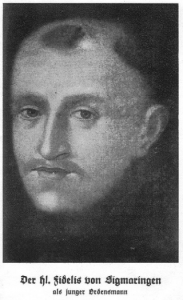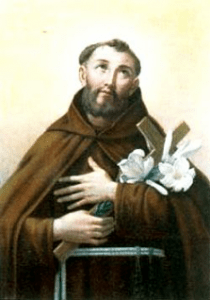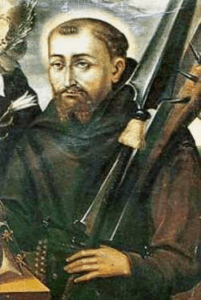Capuchin martyr (1578-1622)
 Born in the town of Sigmaringen in Germany in the year 1578, Fidelis entered the Order of Friars Minor Capuchin where he led an austere life of penance, vigils and prayer. He had a reputation as an indefatigable preacher and he was ordered by the Sacred Congregation for the Propagation of the Faith to preach in the canton of Grisons in Switzerland. There he was pursued by the heretics and suffered martyrdom in 1622 at Seewis. He was beatified by Pope Benedict XIII in 1729 and canonised in 1746 by Pope Benedict XIV.
Born in the town of Sigmaringen in Germany in the year 1578, Fidelis entered the Order of Friars Minor Capuchin where he led an austere life of penance, vigils and prayer. He had a reputation as an indefatigable preacher and he was ordered by the Sacred Congregation for the Propagation of the Faith to preach in the canton of Grisons in Switzerland. There he was pursued by the heretics and suffered martyrdom in 1622 at Seewis. He was beatified by Pope Benedict XIII in 1729 and canonised in 1746 by Pope Benedict XIV.
Beatified by Benedict XIII on 24 March 1729 and canonised on 29 June 1746 by Benedict XIV, Fidelis of Sigmaringen is the first martyr of Propaganda Fide and the youngest Capuchin saint. He died when he was forty four. He was also the youngest saint in terms of Capuchin life. He’d been a friar only ten years, from 1612 to 1622. He was born in 1578 in the small Danube town (at that time) of Sigmaringen in the Principality of Hohenzollern. His father was Johann Rey, a rich hotelier from Adler who would later be part of the city government and bürgermeister. His mother, Genovefa Rosenberger was from the protestant city of Tübingen. She had become a Catholic when she married Johann on 28 December 1567. The future saint, Markus, (Marx to his family and friends) was the fifth of six children in the family. He completed his first schooling in the town of his birth. In his testament, written before his religious profession (1631), he declared himself to “have been educated in the one, apostolic, Roman, and true faith transmitted to him by his very beloved parents” and to have been “educated in good manners, discipline and the fear of God.”
For his higher studies Markus went to Freiburg im Breisgau. There in the Jesuit college he advanced in classical studies in order to go onto the study of philosophy which, in 1601, he crowned his brilliant degree. At the same time he applied himself to grasp Italian and French. He was particularly open to friendship and brilliant. He appreciated the beautiful and music, and could get by on various musical instruments. Between 1601 and 1604 he followed courses in jurisprudence. In 1591 Markus and his siblings suffered the blow of the death of their father. A year had not passed since the death of her husband when Genovefa re-married with Gabriel Rieber von Ebingen. In his Testament Markus expressed his regret at the second marriage of his mother, which to him and his brothers seemed inopportune and incomprehensible.
Before concluding his studies in 1604 Markus was sent to accompany and guide a number of university students from noble families. They were to visit the Low Countries under Spanish dominion, France and Italy in order to broaden the horizons of their human experiences. He lived this journey as a true and proper pilgrimage, promoting with his example a more spiritual way of life among his friends.
After returning to Freiburg in 1611 he graduated brilliantly in civil and church law in the city of Willingen. In the metropolis of Ensisheim in the Austria of the time, Markus was nominated as an assessor in the supreme court. At the same time he opened a legal office and adhered to the requirements of absolute honesty, lavishing his preference for the poor. A series of negative experiences and the unscrupulous attitude of colleagues who proposed shameless adjustments of lawsuits in order pocket more money provoked in him a distaste for his profession. He began to consider religious life. He read the work on the consecrated life by the Jesuit Girolamo Piatti (†1591) but was hesitant about the choice of Order: Carthusians, Jesuits, Capuchins. Nonetheless he would have had the example of his brother Georg who had become a Capuchin in 1604 with the name Br. Apollonius.
Probably in June 1612 he asked the Minister of the Swiss Capuchin Province, Alexander von Altdorf, to be admitted to the Order. To test him, the superior had him wait and meanwhile suggested he be ordained priest first. He was ordained to the priesthood in September and renewed his request for admission. Finally he was accepted by Br. Angelo Visconti da Milano into the novitiate in Freiburg im Breisgau on 4 October 1612, and he received the name Fidelis. During the year of probation, decided in order to recuperate thirty four ‘lost’ years, there was no shortage of suggestions and temptations to return to the world. He overcame each doubt, however, and persisted resolutely and with commitment. In that period he wrote, for personal use only, a collection of prayers and meditations – essentially a compilation. These show the affective and contemplative tone of his spirituality. Later they were partially published in Freiburg under the title Exercitia spiritualia seraphicae devotionis (in 1746 and 1756). Before taking vows on 4 October 1613 he wrote his will in which provided scholarships for poor young Catholics of the Rey family and other relatives.
After about a year of religious formation at Freiburg, Fidelis began four years of theology in Konstanz under the guidance of a friar of Polish origins, Br. Johann Baptist Fromberger. He concluded these studies at Frauenfeld in 1618. After this he exercised the ministry of preaching with great success in the friary of Altdorf. Then in the same year of 1618 he was appointed guardian of the friary in Rheinfelden. According to the practice at the time he was transferred the following year as preacher and probably as guardian also to the friary of Feldkirch. There he not only led a number of evangelical soldiers back to the Catholic faith but also advanced the process against a woman who had taken up Lutheran teaching.
 In September 1620 obedience called him to preside in the Capuchin fraternity in Freiburg (Switzerland) but in 1621 he returned to Feldkirch. Apart from the office of guardian, he was also entrusted with the spiritual assistance of the soldiers. During an epidemic of petechia he served them in the humblest ways, fearless of the risk of contagion. Following the soldiers into the Grison he preached the Advent in Marienfeld, and brought back to the Catholic faith the noble Rudolf von Gugelberg from Malans. A similar case of conversion, that of Rudolf Andreas de Salis at Zizers at the beginning of 1622, shows his method to approach the reformation leaders first in order to focus then on helping the people back to the Catholic faith. To help his counter-reformation activity, Fidelis wrote some apologetic works. These were published without his knowing but no copy has survived.
In September 1620 obedience called him to preside in the Capuchin fraternity in Freiburg (Switzerland) but in 1621 he returned to Feldkirch. Apart from the office of guardian, he was also entrusted with the spiritual assistance of the soldiers. During an epidemic of petechia he served them in the humblest ways, fearless of the risk of contagion. Following the soldiers into the Grison he preached the Advent in Marienfeld, and brought back to the Catholic faith the noble Rudolf von Gugelberg from Malans. A similar case of conversion, that of Rudolf Andreas de Salis at Zizers at the beginning of 1622, shows his method to approach the reformation leaders first in order to focus then on helping the people back to the Catholic faith. To help his counter-reformation activity, Fidelis wrote some apologetic works. These were published without his knowing but no copy has survived.
Between February and April 1622 he worked as a missionary in Prättigau at the request of the Apostolic Nuncio in Luzern and his provincial minister. While politically subject to Austria, the population of Prättigau had mostly followed Zwingli. The situation of grave tension in Prättigau was exacerbated by interference from France, Spain and the Republic of Venice. Archduke Leopold V of Austria occupied the region with his army under the command of Luigi de Balidrone. This action provoked the anger of the people and a series of violent actions. All the while, Fidelis continued to expound the Catholic faith in his sermons, disputes and talks, despite the opposition and an almost total deaf ear on the part of the population. Fidelis was aware of his great underground opposition from Zwinglian preachers and foresaw his martyrdom. He wrote the so called punitive Mandate or the Ten articles of religion. With this Mandate civil authorities prohibited protestant worship and sent its ministers into exile and obliged all Christians to be present for Catholic preaching on Sundays and feast days. In an age when freedom of conscience was trodden underfoot so frequently the sixth article is surprising. According to the article no one could be constrained to embrace the Catholic faith, go to confession or attend at Mass.
 The publication of the Mandate on 19 April was a signal, in effect, for a general uprising of the people. On 23 April Fidelis celebrated Mass and climbed the pulpit in the church in Grüsch where he received an invitation to preach the following day, on Sunday 24 April, in Seewis im Prättigau. However the invitation was but an excuse to eliminate the formidable protagonist of counter-reformation activity. As he began his sermon – according to a tradition he was explaining the passage of Ephesians 4:5-6 – the audience reacted vigorously. Someone even shot at the preacher, but missed. Fidelis come down from the pulpit and genuflected before the main altar and then left the church by a side door to go to Grüsch. After a few metres he realised that he was surrounded by a group of rebels. They asked if he were ready to embrace their faith. He answered that this was not the reason he came to the valley, but because of the hope that one day they might adhere to his faith. After a moment of hesitation one of the rebels struck Fidelis’ head with a sword. Gravely wounded, the martyr fell to his knees and exclaimed: “Jesus, Mary. O God come to my aid.” Only an enormous fanaticism can explain the ferocity with which his assassins furiously attacked his body with pitchforks, hammers and clubs.
The publication of the Mandate on 19 April was a signal, in effect, for a general uprising of the people. On 23 April Fidelis celebrated Mass and climbed the pulpit in the church in Grüsch where he received an invitation to preach the following day, on Sunday 24 April, in Seewis im Prättigau. However the invitation was but an excuse to eliminate the formidable protagonist of counter-reformation activity. As he began his sermon – according to a tradition he was explaining the passage of Ephesians 4:5-6 – the audience reacted vigorously. Someone even shot at the preacher, but missed. Fidelis come down from the pulpit and genuflected before the main altar and then left the church by a side door to go to Grüsch. After a few metres he realised that he was surrounded by a group of rebels. They asked if he were ready to embrace their faith. He answered that this was not the reason he came to the valley, but because of the hope that one day they might adhere to his faith. After a moment of hesitation one of the rebels struck Fidelis’ head with a sword. Gravely wounded, the martyr fell to his knees and exclaimed: “Jesus, Mary. O God come to my aid.” Only an enormous fanaticism can explain the ferocity with which his assassins furiously attacked his body with pitchforks, hammers and clubs.
The following day, the feast of Saint Mark, the sacristan Johannes Johanni buried the body. The martyr’s head was exhumed in October 1622 and brought to the Capuchin church of Feldkirch. The rest of his remains were buried solemnly in the cathedral crypt of Chur on 5 November the same year. On 16 February 1771 his feast was extended to the universal church. He is the patron saint of the region of Hohenzollern and of jurists. His symbols are the hammer, sword and palm.
Translation based on the article by Oktavian Schmucki in Sulle orme dei santi, edited by Costanzo Cargnoni, Rome, 2000, p. 37-44.
The eulogy on Saint Fidelis, priest and martyr
A man faithful in name and deed
Pope Benedict the Fourteenth honoured Saint Fidelis, the defender of the Catholic faith, in these words:
The abundance of his charity led him to care for the bodily needs of his neighbours: he gathered all who suffered into his fatherly embrace, and supported a great number of poor people by collecting alms for them from many sources.
He relieved the loneliness of widows and orphans by arranging help for them from powerful men and princes; he assisted prisoners by all the means, physical and spiritual, that were in his power; he was tireless in visiting the sick in order to comfort them, to reconcile them to God, and to prepare them for their last agony.
He was never more fruitful in works of mercy than when the Austrian army, stationed in the Alps, was struck by an epidemic and presented a miserable spectacle of pain and death.
Not only was he filled with such great charity. Being a man faithful in name and in deed, he was a notable defender of the Catholic faith, which he tirelessly preached. A few days before he sealed his faith with his blood, in his last speech, as though in a will, he spoke of the Catholic faith in these words:
Catholic faith, how stable, how firm you are, how well‐rooted, how well‐founded on a strong rock. Heaven and earth will pass away, but you can never perish. From the beginning the whole world has spoken against you, but you have triumphed mightily over all.
For this is the Victory which overcomes the world, our faith; this is what has brought the most powerful kings under Christ’s rule, and made peoples the servants of Christ.
What was it that made the holy apostles and martyrs undergo fierce struggles and terrible agonies, if not faith and above all faith in the resurrection?
What is it that has made hermits spurn pleasure, honour and wealth, and live a celibate life in solitude, if not living faith?
What is it that in these days causes true Christians to turn aside from what is easy and pleasant and undergo hardship and labour?
Living faith working through love – this is what leads men to put aside the goods of the present in the hope of those of the future, and to look to the future, rather than to the present.
Prayer
Lord God,
you crowned Saint Fidelis with a martyr’s death,
when, filled with your love,
he was preaching the faith.
Let our lives be rooted in love,
so that with him, and by his prayer,
we may know the power of Christ’s resurrection.
We ask this through our Lord Jesus Christ, your Son,
who lives and reigns with you and the Holy Spirit,
God, for ever and ever. Amen.
